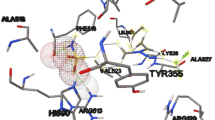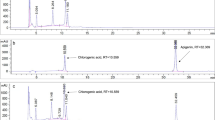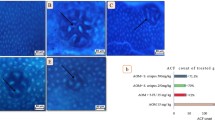Abstract
The present study elucidated the prospective of Azadirachta indica supplementation, if any, in affording chemoprevention by modulating the altered cancer markers and ultrastructural changes in DMH-induced colorectal carcinogenesis in rats. The rats were segregated into four groups viz., normal control, DMH treated, A. indica treated, and DMH+AI treated. Initiation and induction of colon carcinogenesis were achieved through weekly subcutaneous injections of DMH (30 mg/kg body weight) for both 10 and 20 weeks. A. indica extract was supplemented to rats at a dose rate of 100 mg/kg body weight of animals thrice a week on alternative days, ad libitum for two different time durations of 10 and 20 weeks. The study observed a significant increase in the number of aberrant crypt foci in colons of DMH-treated rats at both the time intervals which were decreased significantly upon AI supplementation. Also, a significant increase was seen in the enzyme activity of alkaline phosphatase, which, however, was moderated upon AI administration to DMH-treated rats. Changes in the ultrastructural architecture of colonic cells were apparent following both the treatment schedules of DMH; however, the changes were prominent following 20 weeks of DMH treatment. The most obvious changes were seen in the form of altered nuclear shape and disruption of cellular integrity, which were appreciably improved upon AI supplementation. In conclusion, the study shows the chemopreventive abilities of AI against DMH-induced colorectal carcinogenesis in rats.








Similar content being viewed by others
References
Ao, P., Galas, D., Hood, L., & Zhu, X. (2008). Cancer as robust intrinsic state of endogenous molecular-cellular network shaped by evolution. Medical Hypotheses, 70(3), 678–684.
Jemal, A., Bray, F., & Melissa, M. (2011). Global cancer statistics. CA: A Cancer Journal for Clinicians, 1(69), 69–90.
Manju, V., & Nalini, N. (2005). Chemopreventive efficacy of ginger, a naturally occurring anticarcinogen during the initiation, post-initiation stages of 1,2-dimethylhydrazine-induced colon cancer. Clinica Chimica Acta, 358, 60–67.
Devasena, T., Rajasekaran, K. N., Gunasekaran, G., et al. (2003). Anticarcinogenic effect of bis-1,7-(2-hydroxyphenyl)-hepta-1,6-diene-3,5-dione a curcumin analog on DMH-induced colon cancer model. Pharmacology Research, 47(2), 133–140.
Youhei, I., Atsunobu, M., Murakami, A., & Masanobu, A. (1987). The histogenesis of DHM induced colonic carcinoma in rats. Journal of Gastroentrology, 22(1), 7–17.
Dani, V., Vaiphei, K., & Dhawan, D. K. (2007). Zinc mediated normalization of histoarchitecture and antioxidant status offers protection against initiation of experimental carcinogenesis. Molecular and Cellular Biochemistry, 304(1–2), 101–108.
Dani, V., & Dhawan, D. K. (2010). Ultrastructural changes in rat colon following 1,2-dimethylhydrazine induced colon carcinogenesis—Protection by zinc. Oncology Research, 19(1), 1–11.
Toth, B. L., Malick, H., & Shimizu, (1976). Production of intestinal and other tumors by 1,2-dimethylhydrazine dihydrochloride in mice. I. A light and transmission electron microscopic study of colonic neoplasms. American Journal of Pathology, 84(1), 69–86.
Gangar, S. C., Sandhir, R., Rai, D. V., & Koul, A. (2006). Modulatory effects of Azadirachta indica on benzo(a)pyrene induced forestomach tumorigenesis in mice. World Journal of Gastroenterology, 12, 2749–2755.
Subapriya, R., Kumaraguruparan, R., Abraham, S. K., & Nagini, S. (2005). Protective effects of ethanolic neem leaf extract on DMBA-induced genotoxicity and oxidative stress in mice. Journal of Herbal Pharmacotherapy, 5(4), 39–50.
Subapriya, R., Kumaraguruparan, R., Abraham, S. K., & Nagini, S. (2004). Protective effects of ethanolic neem leaf extract on N-methyl-N′-nitro-N-nitrosoguanidine-induced genotoxicity and oxidative stress in mice. Drug and Chemical Toxicology, 27(1), 15–26.
Soler, A. P., Miller, R. D., Laughlin, K. V., Carp, N. Z., Klurfeld, D. M., & Mullin, J. M. (1999). Increased tight junctional permeability is associated with the development of colon cancer. Carcinogenesis, 1999(20), 1425–1431.
Bergmeyer, H. U. (1963). Phophatase (phosohomonoestrals) determination in serum with p-nitrophenyl phosphatase. In H. V. Bergmeyer (Ed.), Methods of enzymatic analysis (p. 283). New York: Academic press.
Kinzler, K. W., Nilbert, M. C., & Vogelstein, B. (1991). Identification of gene located at chromosome 5q21 that is mutated in colorectal cancer. Science, 251, 1366–1370.
Gadre, S. G., Kale, K. U., Hedge, R., & Raste, A. S. (2000). Comparative study of alkaline phosphatase and prostate specific antigen in prostate cancer. Indian Journal of Medial Science, 54(4), 136–139.
Saif, M. W., Alexander, D., & Wicox, C. M. (2005). Serum alkaline phosphatase level as a prognostic tool in colorectal cancer: A study of 105 patients. Journal of Applied Research, 5(1), 88–95.
Yamaguchi, M., & Yamaguchi, R. (1996). Action of zinc on bone metabolism in rats: increase in alkaline phosphates activity and DNA content. Biochemical Pharmacology, 35(5), 773–777.
Park, E. J., Jeon, C. H., Ko, G., Kim, J., & Sohn, D. H. (2000). Protective effect of curcumin in rat liver injury induced by carbon tetrachloride. Journal of Pharmaceutical Pharmacology, 52(4), 437–440.
Takatsugu, O., Rey-Chen, P., Li, Y., & Hseih, J.-T. (2004). The role of cancer adhesion molecule in cancer progression and its application in cancer therapy. Acta Biochemica Polonica, 2004(51), 445–457.
Dani, V., & Dhawan, D. K. (2009). Membrane fluidity and surface changes during initiation of 1,2-dimethylhydrazine induced colon carcinogenesis: Protection by Selenium. Oncology Research, 2009(18), 17–23.
Author information
Authors and Affiliations
Corresponding author
Rights and permissions
About this article
Cite this article
Liu, N., Sun, B., Wu, P. et al. Chemopreventive Effects of Azadirachta indica on Cancer Marker Indices and Ultrastructural Changes During 1,2-Dimethylhydrazine-Induced Colon Carcinogenesis in Rats. Cell Biochem Biophys 73, 101–106 (2015). https://doi.org/10.1007/s12013-015-0621-9
Published:
Issue Date:
DOI: https://doi.org/10.1007/s12013-015-0621-9




